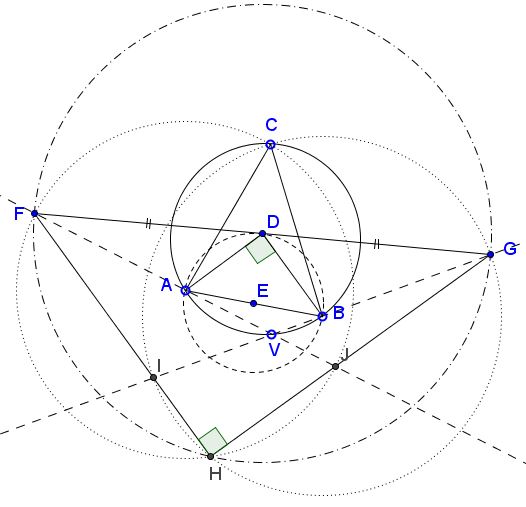Looking Back at Bottema
What Might This Be About?
Problem
Given $\Delta ABC$ and point $V$ on its circumcircle $(ABC).$ Draw circle $C(A)$ through $C$ with center $A$ and, similarly defined circle $C(B).$ Let the ray from $V$ through $A$ meet $C(A)$ in $F$, and that from $V$ through $B$ meet $C(B)$ at $G.$

Then
$D,$ the midpoint of $FG,$ lies on the circle with diameter $AB$ so that $\angle ADB=90^{\circ},$
$D$ is independent of the position of $C$ if, when $C$ moves, $V$ is chosen to preserve angles $FAC$ and $GBC.$
If $H$ is the second intersection of $C(A)$ and $C(B)$ then $\angle FHG=90^{\circ},$ so that $H$ also lies on the circle with diameter $FG,$
Point $I$ the intersection of $VB$ and $FH$ lies on $C(B)$ and similarly defined $J$ lies on $C(A).$
Solution
Quadrilateral $AVBC$ is cyclic, implying that angles $CBV$ and $CAV$ are supplementary, .i.e., $\angle CBV+\angle CAV=180^{\circ}.$ By the construction, so are angles $CAV$ and $CAF$ and also $CBV$ and $CBG,$ implying that angles $CAF$ and $CBG$ are supplementary, which, with a reference to a generalization of Bottema's theorem, shows that $\angle ADB=90^{\circ}$ such that $D$ lies on the circle with diameter $AB.$
But this is also possible toestablish #1 directly, without invoking the generalization of Bottema's theorem and, thus providing an alternative (and purely synthetic) proof of the latter. Indeed, due to Thales' theorem, the parallel to $GH$ through $A$ meets $FG$ at its midpoint $D$ but $BD$ is parallel with $FH$ therefore $\angle ADB$ is right and $D$ is on the circle with diameter $AB,$ as required.
Let $I$ be the point where $GB$ meets $C(B)$ again and let $H$ be where $FI$ meets $C(B)$ again. Since $BI$ is a diameter of $C(B),$ $\angle IHG=90^{\circ}.$ Since $\angle FHG=90^{\circ},$ the intersection $J$ of $HG$ with $C(A)$ must be its diameter, $H$ must be on $C(A)$ and $FG$ must be the diameter of $(FGH).$
Acknowledgment
The appearance of point $V$ in the setup of the generalization of Bottema's theorem is due to Hubert Shutrick's insight that the generalization could be formulated without invoking rotations; points $I,J,H$ emerged in a follow-up investigation; their properties proved by Hubert Shutrick.
Bottema's Theorem
- Bottema's Theorem
- An Elementary Proof of Bottema's Theorem
- Bottema's Theorem - Proof Without Words
- On Bottema's Shoulders
- On Bottema's Shoulders II
- On Bottema's Shoulders with a Ladder
- Friendly Kiepert's Perspectors
- Bottema Shatters Japan's Seclusion
- Rotations in Disguise
- Four Hinged Squares
- Four Hinged Squares, Solution with Complex Numbers
- Pythagoras' from Bottema's
- A Degenerate Case of Bottema's Configuration
- Properties of Flank Triangles
- Analytic Proof of Bottema's Theorem
- Yet Another Generalization of Bottema's Theorem
- Bottema with a Product of Rotations
- Bottema with Similar Triangles
- Bottema in Three Rotations
- Bottema's Point Sibling
![]()
|Contact| |Front page| |Contents| |Geometry|
Copyright © 1996-2018 Alexander Bogomolny73608629
